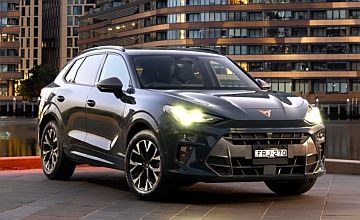Make / Model Search
OptionsCar reviews - Cupra - TerramarCupra modelsOverviewWe like Sweet chassis and steering, tight dimensions but roomy cabin, generous standard equipment, even in the base grade, effective mild hybrid system, S’s fuel economy and compliant ride, VZ’s pace and grip Room for improvement Relatively expensive to buy, lack of online connectivity and full-featured companion app, obtrusive driver monitors require silencing, AWD versions are thirsty in town Lots of equipment, and plenty of soul, the Terramar is ready to rock ‘n’ roll7 Aug 2025 By TOM BAKER Overview
OFFBEAT advertising, lush styling, and whispered “if you know, you know” word-of-mouth referrals have been sufficient to make the Volkswagen Group (VAG)’s Catalonian marque Cupra known to 60 per cent of Australian new car buyers.
When VAG’s Czech value play Skoda launched locally, in-tune GTI fans discovered they could buy the same driveline in an Octavia RS for a lot less money. Cupra’s play – stuffing the best Golf/Tiguan oily bits into the super-svelte Formentor crossover – has drawn Aussie fans of its own.
But ‘three-fifths’ consumer recognition is simply off the pace if Cupra is to hit its target of 7000 sales, self-imposed when the brand launched locally in 2023. While that demand from headquarters in Martorell, Spain, has now been relaxed, the brand’s 2024 result of 2339 wasn’t sufficient.
A pivot is now underway to push Cupra into family-friendly, volume-rich segments without losing the Barcelonan flair that lets this VAG outlet stand out. With the Tavascan midsize BEV generating modest results, the mission sits atop the shoulders of the new combustion-powered Terramar.
Shrewd Cupra Australia product planners have squeezed incredible levels of standard kit from their Spanish paymasters, and while the 4519mm-long, Tiguan-sized Terramar is not nearly the cheapest midsize SUV on the Australian market, it is brilliantly specified from base.
In fact, the base Terramar S ($58,490 driveaway) is so compelling, sans options, that few will need to walk past its chic yet democratic offer.
Standard is the combination of 18-inch wheels and passive dampers, LED headlights, a ‘coast-to-coast’ LED rear light bar, power tailgate, Dinamica/artificial leather upholstery, heated/power-adjustable front seats (with driver’s memory), and a heated leather steering wheel.
Standard specification also takes in a nine-speaker stereo, 12.9-inch touchscreen/10.25-inch instrument cluster, wireless Apple CarPlay/Android Auto, smart entry and push-button start, tri-zone climate control (with rear air vents), and selectable drive modes.
Possibly objectionable may be the Terramar S’s front-wheel drive layout, matched to a VAG ‘EA211 Evo’ 1.5-litre turbocharged petrol four-cylinder engine and 48-volt mild hybrid system making 110kW/250Nm.
The big drawcard of the mid-tier Terramar V ($66,490 d/a) is an upgrade to a 2.0T/AWD powertrain of 150kW/320Nm, with the V also adding 19-inch copper/black wheels, hill descent control, and bigger front brakes.
Many S and V customers will opt for the Leather and Sound Package ($1600) adding deep burgundy leather and a 12-speaker Sennheiser stereo, and an opening panoramic sunroof with blind ($2000).
Top-tier Terramar VZ ($73,490 d/a) makes the Leather and Sound Package standard while adding 20-inch rims, 15-stage DCC Pro adaptive dampers, matrix LED headlight tech, big rear brakes and an all-out Cupra drive mode.
Before Christmas, the 200kW/400Nm Terramar VZe plug-in hybrid (PHEV) will land in Australia promising 111-115km electric driving range (WLTP). Precise specification, and pricing, are yet unknown for the PHEV.
Most colours are at no charge with only Dark Void (purple) and Graphene Grey attracting a $620 premium while two matte hues – Century Bronze, and Enceladus Grey – will be added later at a hefty $2900 upcharge.
Claimed fuel economy kicks off at 5.7L/100km (S), with the bigger-engine AWD models drinking more (7.2L/100km V, 8.2L/100km VZ). The latter pair also score a larger fuel tank (60L vs 55L).
Pre-paid service plans cost $1490 (three years/45,000km) or $2590 (five years/75,000km) while warranty is five years with unlimited kilometres.
Driving Impressions
In photographs, the Terramar looks upright, even staid, compared to the slick Formentor. In the metal, this more pragmatic Cupra SUV still offers visual flair and interest, with extensive use of triangular motifs; the only ‘Terramar’ branding is a tiny label in the crystal LED taillights.
Still, the more estate-like roofline of the Terramar signals this Cupra’s family-first credentials, and boot space (508-642L, depending on the sliding rear bench position) and rear headroom alike are easily superior to the compromised Formentor, or Leon hatch.
We wouldn’t call it frumpy, even on the base model’s sensibly sized 18-inch wheels wrapped in chunky tyres. It’s gracefully grown up; Cupra marketing might major on “young, urban rebels”, but the Terramar shows it’s possible to retain some cool factor, even as a parent…
Where the Terramar has retained plenty of soul is in the cabin, which still feels quite selfishly driver-focussed up front with a lush, wrap-around centre console with 3D-printed texture and a gorgeous, thin-rimmed perforated leather steering wheel.
Seat comfort (and upholstery quality) is of the highest order, combining VAG’s typically firm but supportive pew shaping with aesthetic flair; the High Canyon interior theme that features on leather-trimmed cars is beautiful, eschewing boring black for the deepest possible burgundy.
VAG has taken complaints about HMI/ergonomics on board in recent years and while the Terramar sports a touch-capacitive temperature slider, it is redundant as the clear main screen has an always-on climate bar. The steering wheel’s physical controls are a delight to use.
There is maturity here: key controls fall close to hand, controls are evenly weighted, and menu structures are intuitive. There is little learning curve to the Terramar, you can jump in and get started with it quickly.
While the Terramar is a concession to family life, and the back bench does fit two six-footers fine, its tight dimensions avoid the bloat seen in many rival crossovers (such as the next-gen Mazda CX-5), making the Cupra a good choice for inner-city dwellers with tiny parking spaces.
Cupra knows it has a gap in its lineup for a properly big SUV and it’s working on that. For now, Terramar (and the slightly bigger Tavascan BEV) are as capacious as it gets.
While family interests are looked after, we like the fact the Terramar biases the driver and makes clear that dynamics are of central importance. This isn’t another family SUV that sweeps ride, handling and powertrain excellence under the rug in favour of the bland.
The high boost 195kW VZ is seriously rapid, bordering on the frenetic. It combines immediate torque with high grip levels, though a higher centre of gravity and extra 150kg means the quickest Terramar falls about 20 per cent short of a smaller Formentor VZx’s fun factor.
We found the entry Terramar S to feel most comfortable in its own skin. It too enjoys the Cupra’s great chassis, which gives keen drivers options, but the base version’s blend of 18s, high-profile tyres, and firm but compliant passive dampers, hits a dynamic sweet spot.
The 1.5-litre mild hybrid powertrain is a sophisticated quiet achiever, appearing to outpunch its academically modest outputs while liberally filling in the driveline’s off-boost gaps and shift points with fill-in torque from the 48-volt, upgraded alternator.
Dropping the AWD system and avoiding the EA888 2.0-litre’s well-established thirst, the front-drive Terramar S also chalks up impressive efficiency in the real world: we saw 5.3L/100km on the highway for theoretical range of 1037km.
Combined consumption is slightly thirstier than common series-parallel hybrids, but this modest mild hybrid sips fuel while offering fluency and European dynamic prowess in spades.
The 150kW/320Nm V lands soon. In the related Volkswagen Tiguan, this powertrain is the sweet spot, and it may be too in the Terramar.
By contrast to the slick tuning of the Cupra’s Travel Assist system, a strengthened adaptive cruise control/lane centring mode which happily drives semi-autonomously on highways with just a palm on the steering wheel, oversensitive driver monitors are a disappointment.
Encroaching safety regulations enforces such blight, but the Terramar’s too-vigilant driver attention monitor is especially annoying. Thankfully, audible speed warning beeps can be silenced with two taps of the steering wheel, though this has to be done every time you drive the SUV.
The Terramar enters the Australian market simultaneously with new-brand SUVs promising greater levels of electrification for less and less money, seemingly miraculous value equations appear almost daily.
Cupra (and VAG generally) doesn’t appear to want to compete in the race to the bottom. Instead, the Terramar goes back to basics. Prospective owners pay a bit more, but they receive a vehicle with genuine polish in return.  Read more5th of August 2025  Cupra Raval coming to Australia, big SUV nextCupra prepares to add smallest and biggest models in succession, both electric-only4th of August 2025  Cupra to adjust trims, engines across line-upPopular VZx high-performance trims protected as Cupra adds more hybrids to meet NVES10th of June 2025  Cupra Terramar priced for AustraliaMild-hybrid and turbo-petrol Cupra Terramar available in July priced from $53,990All car reviews Alfa Romeo Alfa Romeo Abarth Abarth Audi Audi Aston Martin Aston Martin BMW BMW Bentley Bentley Chrysler Chrysler Chevrolet Chevrolet Dodge Dodge Citroen Citroen Ferrari Ferrari DS DS Ford Ford Fiat Fiat FPV FPV Foton Foton Haval Haval Great Wall Great Wall Honda Honda Holden Holden Hyundai Hyundai HSV HSV Isuzu Isuzu Infiniti Infiniti Jaguar Jaguar Iveco Iveco Kia Kia Jeep Jeep Land Rover Land Rover Lamborghini Lamborghini Maserati Maserati Lexus Lexus McLaren McLaren Mazda Mazda Mercedes-Benz Mercedes-Benz Mitsubishi Mitsubishi Mini Mini Opel Opel Nissan Nissan Porsche Porsche Peugeot Peugeot Ram Ram Proton Proton Rolls-Royce Rolls-Royce Renault Renault Skoda Skoda Saab Saab SsangYong SsangYong Smart Smart Suzuki Suzuki Subaru Subaru Toyota Toyota Tesla Tesla Volvo Volvo |
OptionsClick to share
|











Facebook Twitter Instagram